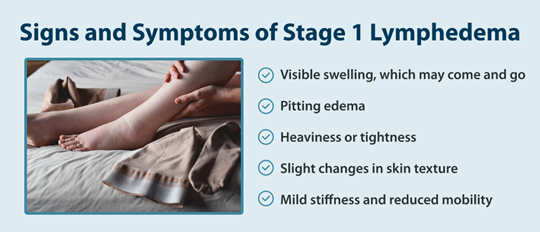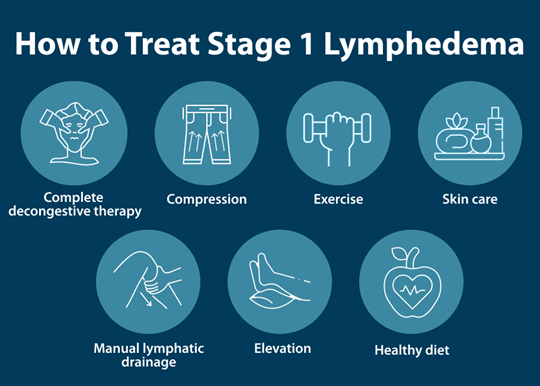Lymphedema and Weight Loss
Living with lymphedema while trying to manage your weight can feel overwhelming, but understanding the connection between lymphedema and weight loss can help you develop effective strategies for both conditions.
Read More
When the lymphatic system becomes compromised, fluid buildup can lead to stage 1 lymphedema, a condition marked by mild but noticeable swelling in affected areas. This initial stage is a crucial window for intervention, as proper treatment can prevent progression to more severe stages.
Knowing the signs, causes, and treatment options for stage one lymphedema can help you take control of your health and work with your healthcare team to manage this condition.
Stage 1 lymphedema is the earliest clinically detectable phase of this progressive condition. Unlike stage 0 lymphedema (the subclinical stage), where symptoms aren’t yet visible but changes are occurring within the body, stage 1 presents noticeable signs that can alert you to the need for intervention.
During this stage, the lymphatic system’s ability to transport fluid becomes compromised, leading to visible swelling that may come and go throughout the day. Fortunately, stage one lymphedema is often reversible with proper care and treatment.
However, without appropriate intervention, the condition can progress to more severe stages where permanent changes to the tissue may occur.1
Recognizing the symptoms of stage 1 lymphedema early can make a significant difference in outcomes. While some signs might seem subtle at first, they shouldn’t be ignored. Common symptoms of stage 1 lymphedema include:2

Knowing the causes of lymphedema can help you better manage your condition and take appropriate precautions. The condition generally develops through two main pathways.
Primary lymphedema occurs when genetic factors affect the function of the lymphatic system. This type can appear at any age but is often present from birth or develops before adulthood. The genetic variations responsible for primary lymphedema can affect the number, size, or function of lymph vessels and nodes.
The more common form of lymphedema is secondary lymphedema. This condition develops as a result of damage or disruption to the lymphatic system, which can occur due to various factors, such as:1
Early diagnosis of stage 1 lymphedema ensures optimal treatment outcomes. Healthcare providers use several methods to confirm the condition and rule out any other potential causes of the swelling. The diagnostic process typically involves a comprehensive approach using multiple tools and techniques, such as:
Once your healthcare provider accurately diagnoses the condition, you’ll learn how to treat lymphedema. Treatment for stage 1 lymphedema focuses on reducing swelling, preventing progression, and improving quality of life. A comprehensive approach typically yields the best results, combining various therapeutic methods to address different aspects of the condition:2

Taking action during the first stage of lymphedema offers the best chance of managing symptoms and preventing progression to more advanced stages. With proper care and consistent treatment, many people successfully manage their condition and maintain their quality of life. Don’t hesitate to contact healthcare professionals if you notice any signs of lymphedema—early intervention can help you achieve the best possible treatment outcomes.
To enhance your lymphedema management plan, consider asking your doctor about pneumatic compression devices like the Flexitouch Plus or Nimbl systems from Tactile Medical. These specialized devices work alongside other treatments to help maintain progress and support long-term symptom management.
References:
1. Greene, Arin K, and Jeremy A Goss. “Diagnosis and Staging of Lymphedema.” Seminars in Plastic Surgery, U.S. National Library of Medicine, Feb. 2018, pmc.ncbi.nlm.nih.gov/articles/PMC5891654/.
2. “Lymphedema: Symptoms, Causes & Treatment.” Cleveland Clinic, 22 Jan. 2025, my.clevelandclinic.org/health/diseases/8353-lymphedema.
Living with lymphedema while trying to manage your weight can feel overwhelming, but understanding the connection between lymphedema and weight loss can help you develop effective strategies for both conditions.
Read More
Stage three lymphedema is the most advanced stage of this chronic condition. In this stage, the affected body part might display one or more symptoms, such as significant swelling, alterations in the skin, or recurring episodes of infection. While this stage can be challenging to manage, understanding your condition and...
Read More
Living with stage 2 lymphedema brings unique challenges, but understanding your condition is the first step toward effectively managing it. While this stage marks a point where the condition becomes irreversible, there are many ways to maintain your quality of life and prevent symptoms from progressing. Keep reading to explore...
Read More
Read More
Call us at 1.800.575.1900